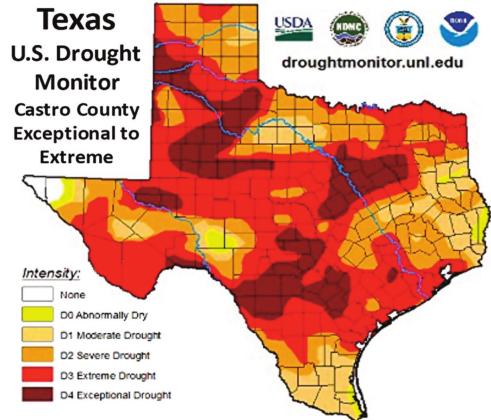There are currently 224 counties under a burn ban - including Castro County - the most the state has seen since Oct 24, 2011.
Castro County is currently experiencing extreme to exceptional drought, according to the U.S. Drought Monitor and experiencing the same high temperatures and evaporative effect of other struggling areas of the Panhandle and South Plains region. Residents in the area should use extreme caution as the threat of wildfire increases.
With a persistent lack of rain, increasing dry conditions and a heat wave, many parts of Texas, including the Texas Panhandle, Texas has already had more than 40 days with above 100-degree temperatures. From June 1 to July 18, a combined 27 monthly record-high maximum temperatures have either been tied or broken in Texas, Oklahoma, Kansas and New Mexico. Precipitation has been less than 25 percent of normal for this time of year and the evaporative demand has been persistently high for the past four weeks.
Continued temperatures above 100 degrees will draw moisture from live vegetation. Mid-July live fuel are at critical levels, making tree torching, or the transition of fire from the ground to the canopy of trees, likely with elevated fire weather conditions.
Texas A&M Forest Service monitors live fuel moistures across the state. The data collected from these sample sites is used to determine the condition of vegetation and assists fire managers in deciding where to position resources.
“As conditions continue to deteriorate for much of the state, we remain proactive in ensuring the state has the necessary resources to respond to any wildfire,” said Wes Moorehead, Texas A&M Forest Service Fire Chief.
“Wildfire activity is occurring across the state, from border to border, and requires a lot of support. Texas A&M Forest Service continues to mobilize additional firefighters, equipment and aircraft, positioning them across the state for a quick response.”
In addition to the 300 Texas A&M Forest Service firefighters, there are 1,080 firefighters from land management agencies across the nation as well as via the Texas Intrastate Fire Mutual Aid System mobilized by the agency to assist with wildfire response.
Texas A&M Forest Service has also positioned 40 aircraft at 17 airports across the state to respond to wildfire incidents. Texas A&M Forest Service does not own any aviation resources but instead uses federal aviation contracts through the U.S. Forest Service and Bureau of Land Management for all firefighting aircraft.
“We need Texans to prevent wildfires from occurring under these conditions,” said Emily Wall, Texas A&M Forest Service Chief Operating Officer of Forest Resource Protection. “It is imperative that everyone remains diligent with any activity that may cause a spark and check with local officials for burn bans or other restrictions.”
Wall said as hot temperatures and dry conditions continue, always obey local burn bands and outdoor burning restriction.
“Nine out of ten wildfires are human caused. When your county is under a burn ban, residents should avoid outdoor activities that may cause a spark, this includes welding, grinding, and using heavy machinery. Residents should stay up to date on weather conditions and always use extreme caution when performing outdoor activities even if not under a burn ban.”
According to the Climate Prediction Center’s monthly outlook for August, increased temperatures are likely across the Southern Plains region.
Residents are encouraged to stay wildfire aware. If a wildfire is spotted, immediately contact local authorities. A quick response can help save lives and property.

